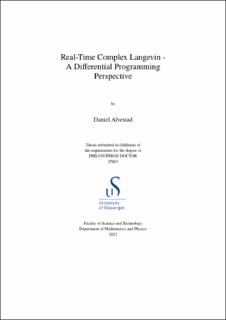| dc.contributor.advisor | Rothkopf, Alexander | |
| dc.contributor.author | Alvestad, Daniel | |
| dc.date.accessioned | 2023-10-03T07:35:54Z | |
| dc.date.available | 2023-10-03T07:35:54Z | |
| dc.date.issued | 2023 | |
| dc.identifier.citation | Real-Time Complex Langevin - A Differential Programming Perspective by Daniel Alvestad, Stavanger : University of Stavanger, 2023 (PhD thesis UiS, no. 718) | en_US |
| dc.identifier.isbn | 978-82-8439-186-1 | |
| dc.identifier.issn | 1890-1387 | |
| dc.identifier.uri | https://hdl.handle.net/11250/3093645 | |
| dc.description.abstract | In this thesis, I aim to find solutions to the NP-hard sign-problem that arises when modeling strongly correlated systems in real-time. I will use the complex Langevin (CLE) method, and address its problem of runaway trajectories and incorrect convergence using an implicit solver and a novel kernel optimization scheme, respectively. The implicit solver stabilizes the numerical solution, making the runaway solution problem a thing of the past. It also acts as a regulator, allowing for simulation along the canonical Schwinger-Keldysh contour. Additionally, our investigation shows that a kernel can act as a regulator as well, resulting in an effective change in the action and integral measure while leaving the path integral measure intact.
To restore correct convergence in CLE simulations, we present a novel strategy that involves learning a kernel and utilizing functionals that encode relevant prior information, such as symmetries or Euclidean correlator data. Our approach recovers the correct convergence in the non-interacting theory on the Schwinger-Keldysh contour for any real-time extent. It achieves the correct convergence up to three times the real-time extent of the previous benchmark study for the strongly coupled quantum anharmonic oscillator.
Furthermore, we investigate the stability of the CLE by calculating the Lyapunov exponents of the CLE and uncovering that the real-time CLE behaves like a chaotic dynamical system. This has consequences for obtaining a reliable gradient of a loss function that contains a real-time CLE simulation. To address this issue, we adapt the shadowing sensitivity method to a stochastic differential equation (SDE), which allows for calculating a reliable gradient of chaotic SDEs. | en_US |
| dc.language.iso | eng | en_US |
| dc.publisher | University of Stavanger, Norway | en_US |
| dc.relation.ispartofseries | PhD thesis UiS; | |
| dc.relation.ispartofseries | ;718 | |
| dc.rights | Navngivelse 4.0 Internasjonal | * |
| dc.rights.uri | http://creativecommons.org/licenses/by/4.0/deed.no | * |
| dc.subject | fysikk | en_US |
| dc.title | Real-Time Complex Langevin - A Differential Programming Perspective | en_US |
| dc.type | Doctoral thesis | en_US |
| dc.rights.holder | © 2023 Daniel Alvestad | en_US |
| dc.subject.nsi | VDP::Matematikk og Naturvitenskap: 400::Fysikk: 430 | en_US |

